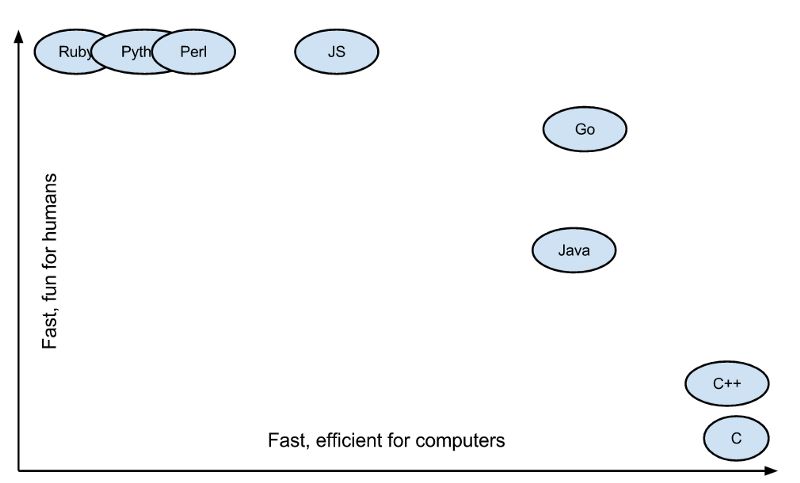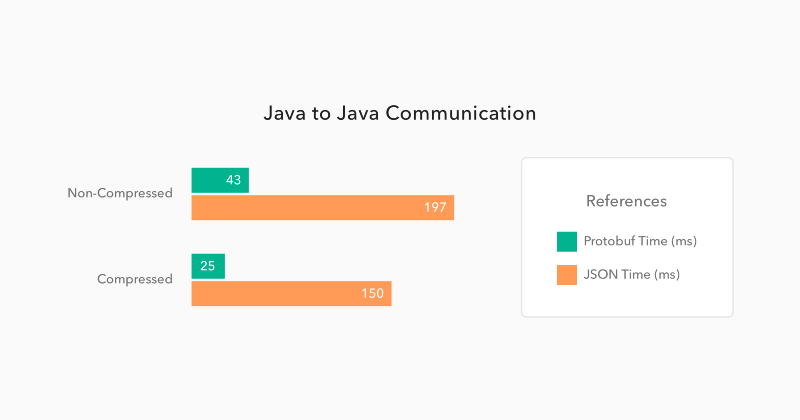
本文由公众号EAWorld翻译发表,转载需注明出处。
作者:Velotio Technologies
译者:白小白
原文:http://t.cn/EaQTFFv
原题:Introduction to the Modern Server-side Stack — Golang, Protobuf, and gRPC
译注:
并发与并行:并发是虚拟的并行,比如通过时间切片技术在单核CPU上运行多个任务,让每个使用者“以为”自己在独占这一CPU资源;并行是实际的同一时间多任务同时运行,多数是指在多核CPU的场景下。
队列与双端队列:队列遵循先入先出的原则,从一端存数,从另一端取数,双端队列支持从队列的两端存数和取数。
阻塞和非阻塞:阻塞和非阻塞描述了程序等待返回结果时的状态,阻塞代表不返回结果就挂起,不进行任何操作;非阻塞是在没返回结果时可以执行其他任务。
合作和抢占:高优先级任务可以打断其他正在运行的低优先级任务,则调度器是抢占式的;反之,则是合作式的。
服务端编程的阵营中有很多新面孔,一水儿的谷歌血统。在谷歌开始将Golang应用于其产品系统后,Golang快速的吸引了大量的关注。随着微服务架构的兴起,人们开始关注一些现代的数据通信解决方案,如gRPC和Protobuf。在本文中,我们会对以上这些概念作一些简要的介绍。
一、Golang
Golang又称Go语言,是一个开源的、多用途的编程语言,由Google研发,并由于种种原因,正在日益流行。Golang已经有10年的历史,并且据Google称已经在生产环境中使用了接近7年的时间,这一点可能让大多数人大跌眼镜。
Golang的设计理念是,简单、现代、易于理解和快速上手。Golang的创造者将Golang设计为一个普通的程序员可以在一个周末的时间就可以掌握,并达到使用Golang进行工作的程度。这一点我已经亲身证实。Golang的创造者,都是C语言原始草案的专家组成员,可以说,Golang根红苗正,值得信赖。
理都懂,但话说回来,为什么我们需要另一门编程语言呢
多数场景下,确实并不需要。事实上,Go语言并不能解决其他语言或工具无法解决的新问题。但在一些强调效率、优雅与直观的场景下,人们通常会面临一系列的相关问题,这正是Go所致力于解决的领域。Go的主要特点是:
- 一流的并发支持
- 内核十分简单,语言优雅、现代
- 高性能
- 提供现代软件开发所需要的原生工具支持
我将简要介绍Go是如何提供上述的支持的。在Go语言的官网可以了解更多的特性和细节。
一流的并发支持
并发是多数服务端应用所需要考虑的主要问题之一,考虑到现代微处理器的特性,并发也成为编程语言的主要关切之一。Go语言引入了“goroutine”的理念。可以把“goroutine”理解为一个“轻量级的用户空间线程”(现实中,当然远比这要复杂得多,同一线程可能会附着多路的goroutine,但这样的提法可以让你有一个大致的概念)。所谓“轻量级”,可以这样理解,由于采用了十分袖珍的堆栈,你可以同时启动数以百万计的goroutine,事实上这也是Go语言官方所推荐的方式。在Go语言中,任何函数或方法都可以生成一个goroutine。比如,只需要运行“go myAsyncTask()”就可以从“myAsyncTask”函数生成一个goroutine。示例代码如下:
// This function performs the given task concurrently by spawing a goroutine// for each of those tasks.func performAsyncTasks(task []Task) { for _, task := range tasks { // This will spawn a separate goroutine to carry out this task. // This call is non-blocking go task.Execute() }}goroutineExample.go hosted with ❤ by GitHub
怎么样,是不是很简单?Go是一门简单的语言,因此注定是以这样的方式来解决问题。你可以为每个独立的异步任务生成一个goroutine而不需要顾虑太多事情。如果处理器支持多核运行,Go语言运行时会自动的以并行的方式运行所有的goroutine。那么,goroutine之间是如何通信的呢,答案是channel。
“channel”也是Go语言的一个概念,用于进行goroutine之间的通信。通过channel,你可以向另一个goroutine传递各种信息(比如Go语言概念里的type或者struct甚至是channel)。一个channel大体上是一个“双端阻塞队列”(也可以单端的)。如果需要goroutine基于特定条件触发下一步的行动,也可以利用channel来实现goroutine的协作阻塞任务模式。
在编写异步或者并发的代码时,goroutine和channel这两个概念赋予了编程者大量的灵活性和简便性。可以籍此很容易的建立其他很有用的库,比如goroutine pool,举个简单的例子:
package executorimport ( "log" "sync/atomic")// The Executor struct is the main executor for tasks.// 'maxWorkers' represents the maximum number of simultaneous goroutines.// 'ActiveWorkers' tells the number of active goroutines spawned by the Executor at given time.// 'Tasks' is the channel on which the Executor receives the tasks.// 'Reports' is channel on which the Executor publishes the every tasks reports.// 'signals' is channel that can be used to control the executor. Right now, only the termination// signal is supported which is essentially is sending '1' on this channel by the client.type Executor struct { maxWorkers int64 ActiveWorkers int64 Tasks chan Task Reports chan Report signals chan int}// NewExecutor creates a new Executor.// 'maxWorkers' tells the maximum number of simultaneous goroutines.// 'signals' channel can be used to control the Executor.func NewExecutor(maxWorkers int, signals chan int) *Executor { chanSize := 1000 if maxWorkers > chanSize { chanSize = maxWorkers } executor := Executor{ maxWorkers: int64(maxWorkers), Tasks: make(chan Task, chanSize), Reports: make(chan Report, chanSize), signals: signals, } go executor.launch() return &executor}// launch starts the main loop for polling on the all the relevant channels and handling differents// messages.func (executor *Executor) launch() int { reports := make(chan Report, executor.maxWorkers) for { select { case signal := <-executor.signals: if executor.handleSignals(signal) == 0 { return 0 } case r := <-reports: executor.addReport(r) default: if executor.ActiveWorkers < executor.maxWorkers && len(executor.Tasks) > 0 { task := <-executor.Tasks atomic.AddInt64(&executor.ActiveWorkers, 1) go executor.launchWorker(task, reports) } } }}// handleSignals is called whenever anything is received on the 'signals' channel.// It performs the relevant task according to the received signal(request) and then responds either// with 0 or 1 indicating whether the request was respected(0) or rejected(1).func (executor *Executor) handleSignals(signal int) int { if signal == 1 { log.Println("Received termination request...") if executor.Inactive() { log.Println("No active workers, exiting...") executor.signals <- 0 return 0 } executor.signals <- 1 log.Println("Some tasks are still active...") } return 1}// launchWorker is called whenever a new Task is received and Executor can spawn more workers to spawn// a new Worker.// Each worker is launched on a new goroutine. It performs the given task and publishes the report on// the Executor's internal reports channel.func (executor *Executor) launchWorker(task Task, reports chan<- Report) { report := task.Execute() if len(reports) < cap(reports) { reports <- report } else { log.Println("Executor's report channel is full...") } atomic.AddInt64(&executor.ActiveWorkers, -1)}// AddTask is used to submit a new task to the Executor is a non-blocking way. The Client can submit// a new task using the Executor's tasks channel directly but that will block if the tasks channel is// full.// It should be considered that this method doesn't add the given task if the tasks channel is full// and it is up to client to try again later.func (executor *Executor) AddTask(task Task) bool { if len(executor.Tasks) == cap(executor.Tasks) { return false } executor.Tasks <- task return true}// addReport is used by the Executor to publish the reports in a non-blocking way. It client is not// reading the reports channel or is slower that the Executor publishing the reports, the Executor's// reports channel is going to get full. In that case this method will not block and that report will// not be added.func (executor *Executor) addReport(report Report) bool { if len(executor.Reports) == cap(executor.Reports) { return false } executor.Reports <- report return true}// Inactive checks if the Executor is idle. This happens when there are no pending tasks, active// workers and reports to publish.func (executor *Executor) Inactive() bool { return executor.ActiveWorkers == 0 && len(executor.Tasks) == 0 && len(executor.Reports) == 0}executor.go hosted with ❤ by GitHub
内核十分简单,语言优雅、现代
与其他多数的现代语言不同,Golang本身并没有提供太多的特性。事实上,严格限制特性集的范围正是Go语言的显著特征,且Go语言着意于此。Go语言的设计与Java的编程范式不同,也不支持如Python一样的多语言的编程范式。Go只是一个编程的骨架结构。除了必要的特性,其他一无所有。
看过Go语言之后,第一感觉是其不遵循任何特定的哲学或者设计指引,所有的特性都是以引用的方式解决某一个特定的问题,不会画蛇添足做多余的工作。比如,Go语言提供方法和接口但没有类;Go语言的编译器生成动态链接库,但同时保留垃圾回收器;Go语言有严格的类型但不支持泛型;Go语言有一个轻量级的运行时但不支持异常。
Go的这一设计理念的主要用意在于,在表达想法、算法或者编码的环节,开发者可以尽量少想或者不去想“在某种编程语言中处理此事的最佳方案”,让不同的开发者可以更容易理解对方的代码。不支持泛型和异常使得Go语言并不那么完美,也因此在很多场景下束手束脚 ,因此在“Go 2”版本中,官方加入了对这些必要特性的考虑。
高性能
单线程的执行效率并不足以评估一门语言的优劣,当语言本身聚焦于解决并发和并行问题的时候尤其如此。即便如此,Golang还是跑出了亮眼的成绩,仅次于一些硬核的系统编程语言,如C/C++/Rust等等,并且Golang还在不断的改进。考虑到Go是有垃圾回收机制的语言,这一成绩实际上相当的令人印象深刻,这使得Go语言的性能可以应付几乎所有的使用场景。

(Image Source: Medium)
提供现代软件开发所需要的原生工具支持
是否采用一种新的语言或工具,直接取决于开发者体验的好坏。就Go语言来说,其工具集是用户采纳的主要考量。同最小化的内核一样,Go的工具集也采用了同样的设计理念,最小化,但足够应付需要。执行所有Go语言工具,都采用 go 命令及其子命令,并且全部是以命令行的方式。
Go语言中并没有类似pip或者npm这类包管理器。但只需要下面的命令,就可以得到任何的社区包:
go get github.com/farkaskid/WebCrawler/blob/master/executor/executor.go
是的,这样就行。可以直接从Github或其他地方拉取所需要的包。所有的包都是源代码文件的形态。
对于package.json这类的包,我没有看到与 goget 等价的命令。事实上也没有。在Go语言中,无须在一个单一文件中指定所有的依赖,可以在源文件中直接使用下面的命令:
import "github.com/xlab/pocketsphinx-go/sphinx"
那么,当执行go build命令的时候,运行时会自动的运行 goget 来获取所需要的依赖。完整的源码如下:
package mainimport ( "encoding/binary" "bytes" "log" "os/exec" "github.com/xlab/pocketsphinx-go/sphinx" pulse "github.com/mesilliac/pulse-simple" // pulse-simple)var buffSize intfunc readInt16(buf []byte) (val int16) { binary.Read(bytes.NewBuffer(buf), binary.LittleEndian, &val) return}func createStream() *pulse.Stream { ss := pulse.SampleSpec{pulse.SAMPLE_S16LE, 16000, 1} buffSize = int(ss.UsecToBytes(1 * 1000000)) stream, err := pulse.Capture("pulse-simple test", "capture test", &ss) if err != nil { log.Panicln(err) } return stream}func listen(decoder *sphinx.Decoder) { stream := createStream() defer stream.Free() defer decoder.Destroy() buf := make([]byte, buffSize) var bits []int16 log.Println("Listening...") for { _, err := stream.Read(buf) if err != nil { log.Panicln(err) } for i := 0; i < buffSize; i += 2 { bits = append(bits, readInt16(buf[i:i+2])) } process(decoder, bits) bits = nil }}func process(dec *sphinx.Decoder, bits []int16) { if !dec.StartUtt() { panic("Decoder failed to start Utt") } dec.ProcessRaw(bits, false, false) dec.EndUtt() hyp, score := dec.Hypothesis() if score > -2500 { log.Println("Predicted:", hyp, score) handleAction(hyp) }}func executeCommand(commands ...string) { cmd := exec.Command(commands[0], commands[1:]...) cmd.Run()}func handleAction(hyp string) { switch hyp { case "SLEEP": executeCommand("loginctl", "lock-session") case "WAKE UP": executeCommand("loginctl", "unlock-session") case "POWEROFF": executeCommand("poweroff") }}func main() { cfg := sphinx.NewConfig( sphinx.HMMDirOption("/usr/local/share/pocketsphinx/model/en-us/en-us"), sphinx.DictFileOption("6129.dic"), sphinx.LMFileOption("6129.lm"), sphinx.LogFileOption("commander.log"), ) dec, err := sphinx.NewDecoder(cfg) if err != nil { panic(err) } listen(dec)}client.go hosted with ❤ by GitHub
上述的代码将把所有的依赖声明与源文件绑定在一起。
如你所见,Go语言是如此的简单、最小化但仍足够满足需要并且十分优雅。Go语言提供了诸多的直接的工具支持,既可用于单元测试,也可以用于benchmark的火焰图。诚然,正如前面所讲到的特性集方面的限制,Go语言也有其缺陷。比如, goget 并不支持版本化,一旦源文件中引用了某个URL,就将锁定于此。但是,Go也还在逐渐的演进,一些依赖管理的工具也正在涌现。
Golang最初是设计用来解决Google的一些产品问题,比如厚重的代码库,以及满足编写高效并发类应用的急迫需求。在需要利用现代处理器的多核特性的场景,Go语言使得在应用和库文件的编程方面变得更加容易。并且,这些都不需要开发者来考虑。Go语言是一门现代的编程语言,简单是其主旨,Go语言永远不会考虑超过这一主旨的范畴。
二、Protobuf(Protocol Buffers)
Protobuf 或者说 Protocol Buffers是由Google研发的一种二进制通信格式,用以对结构化数据进行序列化。格式是什么意思?类似于JSON这样?是的。Protobuf已经有10年的历史,在Google内部也已经使用了一段时间。
既然已经有了JSON这种通信格式,并且得到了广泛的应用,为什么需要Protobuf?
与Golang一样,Protobuf实际上并有解决任何新的问题,只是在解决现有的问题方面更加高效,更加现代化。与Golang不同的是,Protobuf并不一定比现存的解决方案更加优雅。下面是Protobuf的主要特性:
- Protobuf是一种二进制格式,不同于JSON和XML,后者是基于文本的也因此相对比较节省空间。
- Protobuf提供了对于schema的精巧而直接的支持
- Protobuf为生成解析代码和消费者代码提供直接的多语言支持。
- Protobuf的二进制格式带来的是传输速度方面的优化
那么Protobuf是不是真的很快?简单回答,是的。根据Google Developer的数据,相对于XML来说,Protobuf在体积上只有前者的1/3到1/10,在速度上却要快20到100倍。毋庸置疑的是,由于采用了二进制格式,序列化的数据对于人类来说是不可读的。

(Image Source: Beating JSON performance with Proto
相对其他传输协议格式来说,Protobuf采用了更有规划性的方式。首先需要定义 .proto 文件,这种文件与schema类似,但更强大。在 .proto 文件中定义消息结构,哪些字段是必选的哪些是可选的,以及字段的数据类型等。接下来,Protobuf编译器会生成用于数据访问的类,开发者可以在业务逻辑中使用这些类来更方便的进行数据传输。
观察某个服务的 .proto 文件,可以清晰的获知通信的细节以及暴露的特性。一个典型的 .proto 文件类似如下:
message Person { required string name = 1; required int32 id = 2; optional string email = 3; enum PhoneType { MOBILE = 0; HOME = 1; WORK = 2; } message PhoneNumber { required string number = 1; optional PhoneType type = 2 [default = HOME]; } repeated PhoneNumber phone = 4;}protobufExample.proto hosted with ❤ by GitHub
曝个料:Stack Overflow的大牛Jon Skeet也是Protobuf项目的主要贡献者之一。
三、gRPC
gRPC,物如其名,是一种功能齐备的现代的RPC框架,提供了诸多内置支持的机制,如负载均衡、跟踪、健康检查和认证等。gRPC由Google在2015年开源,并由此日益火爆。
既然已经有了REST,还搞个RPC做什么?
在SOA架构的时代,有相当长的时间,基于WSDL的SOAP协议是系统间通信的解决方案。彼时,通信协议的定义是十分严格的,庞大的单体架构系统暴露大量的接口用于扩展。
随着B/S理念的兴起,服务器和客户端开始解耦,在这样的架构下,即使客户端和服务端分别进行独立的编码,也不影响对服务的调用。客户端想查询一本书的信息,服务端会根据请求提供相关的列表供客户端浏览。REST范式主要解决的就是这种场景下的问题,REST允许服务端和客户端可以自由的通信,而不需要定义严格的契约以及独有的语义。
从某种意义上讲,此时的服务已经开始变得像是单体式架构系统一样,对于某个特定的请求,会返回一坨毫无必要的数据,用以满足客户端的“浏览”需求。但这并不是所有场景下都会发生的情况,不是么?
跨入微服务的时代
采用微服务架构理由多多。最常提及的事实是,单体架构太难扩展了。以微服务架构设计大型系统,所有的业务和技术需求都倾向于实现成互相合作的组件,这些组件就是“微”服务。
微服务不需要以包罗万象的信息响应用户请求,而仅需要根据请求完成特定的任务并给出所需要的回应。理想情况下,微服务应该像一堆可以无縫组装的函数。
使用REST做为此类服务的通信范式变得不那么有效。一方面,采用REST API确实可以让服务的表达能力更强,但同时,如果这种表达的能力既非必要也并不出自设计者的本意,我们就需要根据不同的因素考虑其他范式了。
gRPC尝试在如下的技术方面改进传统的HTTP请求:
- 默认支持HTTP/2协议,并可以享受该协议带来的所有好处
- 采用Protobuf格式用于机器间通信
- 得益于HTTP/2协议,提供了对流式调用的专有支持
- 对所有常用的功能提供了插件化的支持,如认证、跟踪、负载均衡和健康检查等。
当然,既然是RPC框架,仍旧会有服务定义和接口描述语言(DSL)的相关概念,REST世代的开发者可能会感觉这些概念有些格格不入,但是由于gRPC采用Protobuf做为通信格式,就不会显得像以前那么笨拙。
Protobuf的设计理念使得其既是一种通信格式,又可以是一种协议规范工具,在此过程中无需做任何额外的工作。一个典型的gRPC服务定义类似如下:
service HelloService { rpc SayHello (HelloRequest) returns (HelloResponse);}message HelloRequest { string greeting = 1;}message HelloResponse { string reply = 1;}serviceDefinition.proto hosted with ❤ by GitHub
只需要为服务定义一个 .proto 文件,并在其中描述接口名称,服务的需求,以及以Protobuf格式返回的消息即可。Protobuf编译器会生成客户端和服务端代码。客户端可以直接调用这些代码,服务端可以用这些代码实现API来填充业务逻辑。
四、结语
Golang,Protobuf和gRPC是现代服务端编程的后起之秀。Golang简化了并发/并行应用的编程,gRPC和Protobuf的结合提供了更高效的通信并同时提供了更愉悦的开发者体验。
关于EAWorld:微服务,DevOps,数据治理,移动架构原创技术分享
不负五月天,山居农家野趣,呼吸森林氧吧,5月18日(周六)和我们一起来一场说走就走的程序员减压旅程!(点击链接了解详情并报名) 【TechJoy限量报名】不负五月天,山居农家野趣,呼吸森林氧吧,一起来嗨!

 鲁公网安备37020202000738号
鲁公网安备37020202000738号